Are you looking for a dog breed that combines regal elegance with an independent spirit? Look no further than the Chow Chow. With its distinctive appearance and aloof personality, this medium-sized working dog has captured the hearts of many.
But what exactly makes the Chow Chow breed unique? From its ancient origins to famous owners, from coat colors to grooming tips, this article will provide you with all the information and characteristics you need to know about the Chow Chow.
So, let’s embark on a journey to uncover the secrets of this fascinating breed.
Key Takeaways
- The Chow Chow is a medium-sized working dog breed with a thick, double coat that comes in various colors.
- The breed originated in China and has a history dating back centuries, with various names associated with it.
- Chow Chows have a temperament that is often compared to that of a cat, with traits such as being aloof, reserved, and independent.
- Proper socialization, training, and care are important for a well-behaved and healthy Chow Chow, including monitoring their diet, exercise, grooming, and potential health issues.
Origin & Size
The Chow Chow dog breed originated in China and is a medium-sized working dog, standing at 18-22 inches tall at the shoulder. They’ve a sturdy build and a distinctive appearance with their thick, double coat. This coat comes in various colors such as red, black, blue, cinnamon, and cream.
The Chow Chow has a rich history, with ancient names including black-tongue dog, wolf dog, bear dog, and Canton dog. The breed gained popularity in the 1920s and even made appearances in the White House.
Known for their aloof and reserved temperament, Chow Chows are often compared to cats. They’re intelligent and dignified but can also be stubborn. Proper socialization during puppyhood is essential for a well-behaved adult Chow Chow.
Breed Group & Lifespan
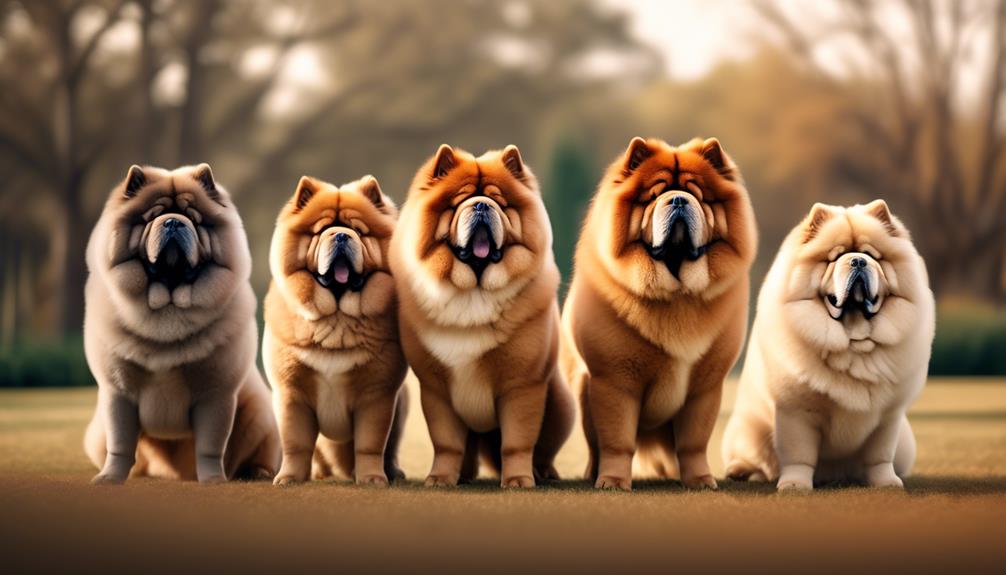
How long do Chow Chows typically live and what breed group do they belong to?
Chow Chows have an average lifespan of 10 to 15 years. They belong to the working dog breed group. This breed group is known for its versatility and willingness to perform various tasks.
Although Chow Chows were originally bred in China for hunting, herding, and guarding, they’re now commonly kept as companion animals. Their strong work ethic and intelligence make them suitable for various working roles such as search and rescue, therapy, and assistance dogs.
Chow Chows are known for their independent and dignified nature, which can sometimes make them challenging to train. However, with proper socialization and firm, consistent training, they can become well-behaved and loyal companions.
Coat Colors & History
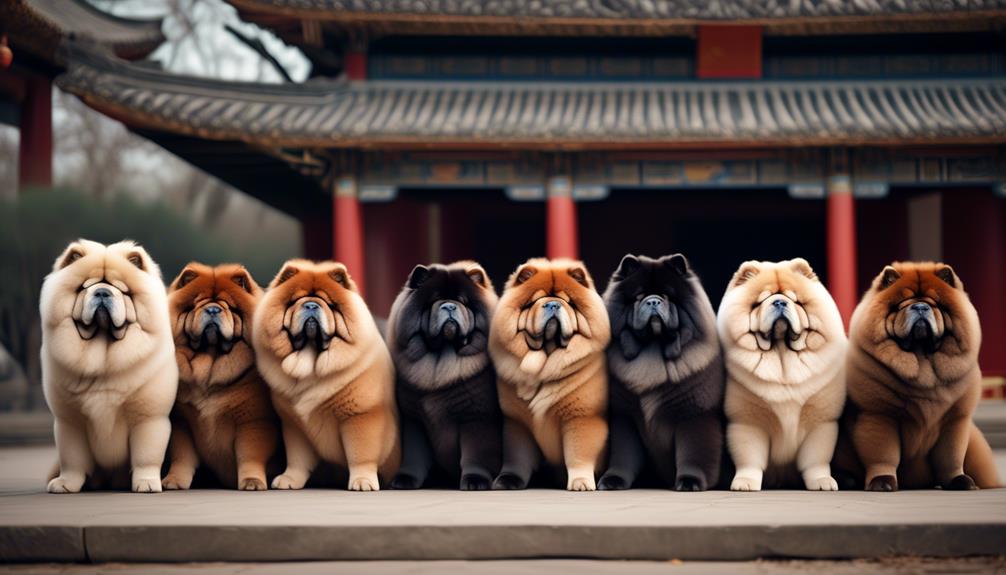
After discussing the breed group and lifespan of Chow Chows, let’s now explore their fascinating coat colors and delve into their rich history.
- Coat Colors:
- Chow Chows have a thick, double coat that comes in five colors: red, black, blue, cinnamon, and cream.
- The red coat can range from a deep mahogany to a lighter golden shade.
- Black Chow Chows have a solid black coat without any other colors.
- Blue Chow Chows have a bluish-gray coat that can range from light to dark.
- Cinnamon Chow Chows have a warm, reddish-brown coat.
- Cream Chow Chows have a light, creamy-colored coat.
- History:
- The Chow Chow breed has ancient names such as black-tongue dog, wolf dog, bear dog, and Canton dog.
- The name ‘Chow Chow’ originated from British merchants in the late 18th century.
- The breed was described in a British book called Natural History and Antiquities of Selbourne in 1781.
- Chow Chows gained popularity in the 1920s, even appearing in the White House.
- Martha Stewart is a fan of Chow Chows, and they rank 64th in popularity among AKC-recognized breeds.
Chow Chow Popularity & Famous Owners
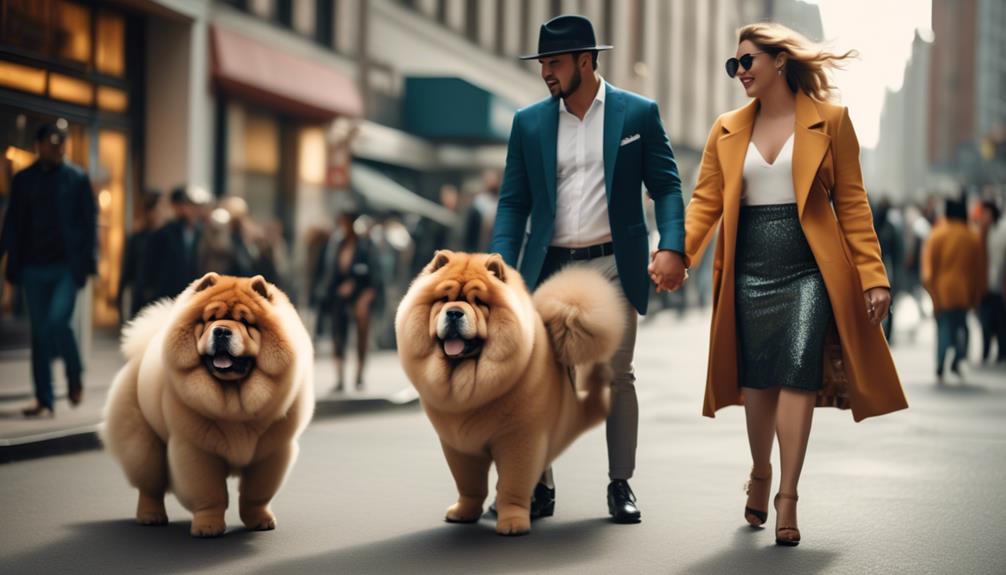
Chow Chows have gained recognition and popularity among dog enthusiasts and even caught the attention of some famous owners. One well-known fan of the breed is Martha Stewart. Chow Chows have also made appearances in the White House, further adding to their appeal.
Despite ranking 64th in popularity among AKC-recognized breeds, Chow Chows continue to have a dedicated following. Their unique and distinctive appearance, with their thick double coat and lion-like mane, contributes to their appeal. Additionally, their aloof and reserved temperament, often compared to that of a cat, adds to their mystique. However, it’s important to note that well-bred Chows should never be aggressive or shy.
With their dignified presence and independent nature, Chow Chows have become beloved companions for many dog lovers, including some well-known individuals.
Size & Personality Traits
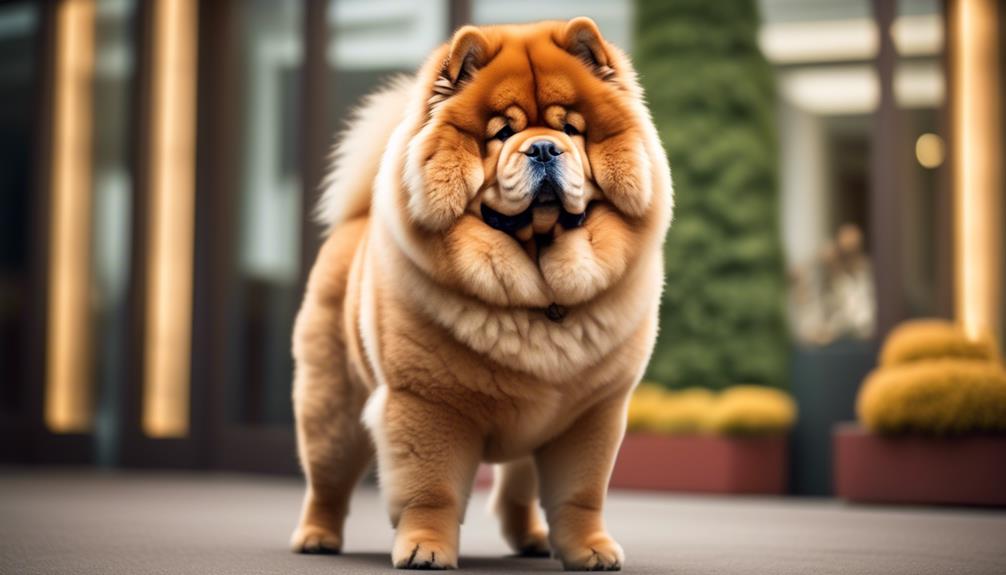
The Chow Chow breed is known for its distinctive size and unique personality traits. When it comes to size, Chow Chows are considered medium-sized dogs, standing between 17 to 20 inches tall at the shoulder and weighing between 40 to 70 pounds.
As for their personality, Chow Chows are often compared to cats due to their aloofness, reserve, and independence. They have a dignified and intelligent demeanor, but can also be stubborn at times. Well-bred Chows should never display aggression or shyness. They typically keep to themselves and avoid causing trouble.
However, extensive socialization during puppyhood is crucial to ensure a safe and relaxed adult Chow Chow. While they may challenge trespassers, they can allow strangers to touch them if properly introduced.
Temperament & Socialization Importance
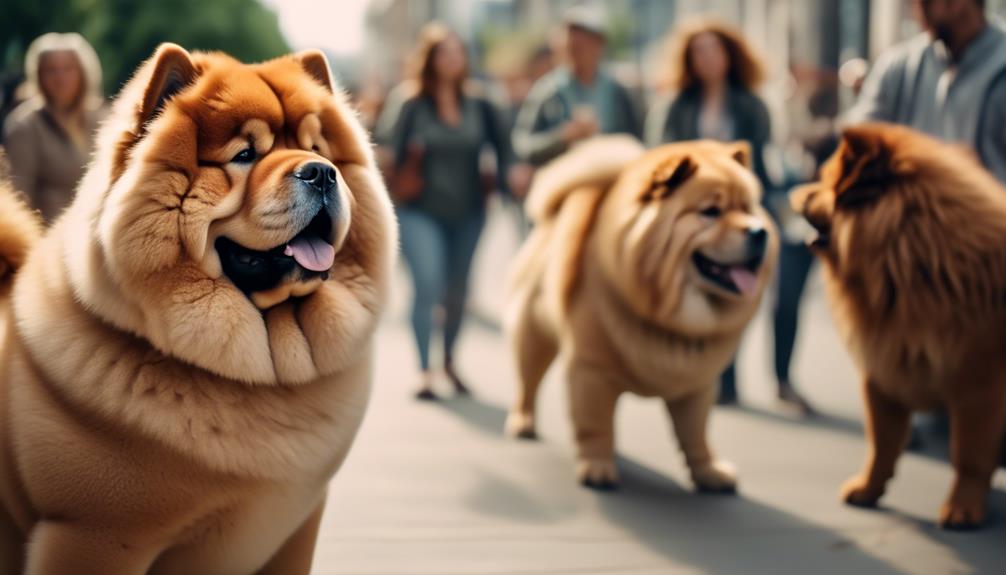
To ensure a well-rounded Chow Chow, it is essential to understand their temperament and the importance of socialization. Chow Chows are often compared to cats in terms of their temperament – aloof, reserved, independent, dignified, intelligent, and stubborn. While they may keep to themselves and avoid causing trouble, extensive socialization during puppyhood is crucial for a safe and relaxed adult. Chows will challenge trespassers but allow strangers to touch them if properly introduced. Socialization helps them become more comfortable around other dogs, animals, and people, reducing the chances of fear or aggression. A well-socialized Chow Chow is more adaptable to new situations, less likely to develop behavioral issues, and easier to handle in various environments.
| Temperament | Characteristics | Importance of Socialization |
|---|---|---|
| Aloof | Reserved | Ensures a safe and relaxed adult |
| Independent | Dignified | Reduces fear and aggression |
| Intelligent | Stubborn | Enables adaptability and reduces behavioral issues |
Health Concerns & Care
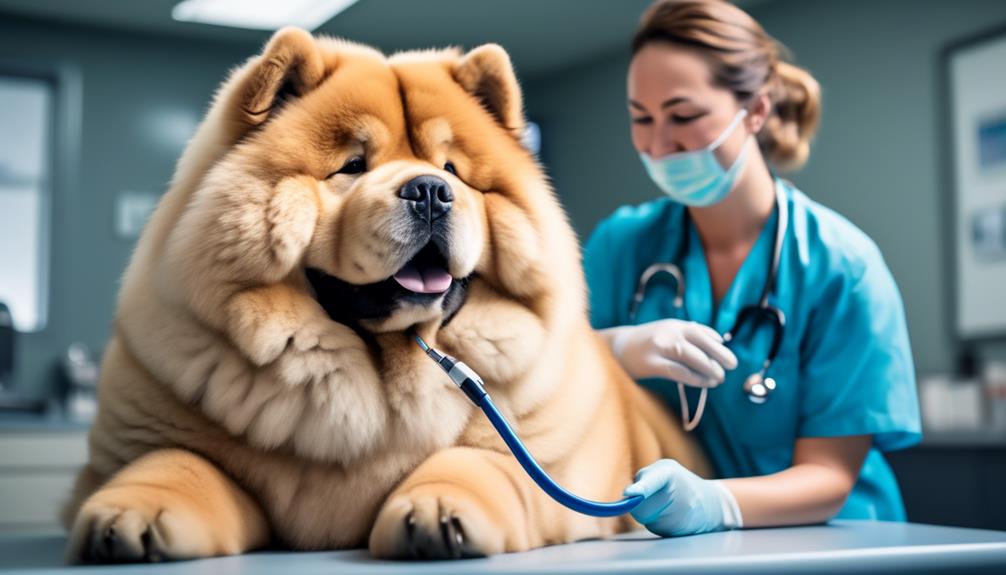
After understanding the temperament and socialization needs of a Chow Chow, it’s important to address the health concerns and care required for this breed. Owning a Chow Chow comes with specific responsibilities and considerations to ensure their well-being:
- Health Concerns:
- Hip dysplasia and elbow dysplasia: Regular veterinary check-ups and appropriate exercise can help manage these conditions.
- Entropion: This eye condition can be corrected surgically if necessary.
- Bloat: Feeding smaller, frequent meals and avoiding vigorous exercise after eating can reduce the risk.
- Allergies: Identifying and avoiding potential allergens can help alleviate symptoms.
- Cataracts: Regular eye exams can detect and monitor the progression of cataracts.
- Care:
- Indoor living: Chows thrive when kept indoors with their human companions.
- Daily exercise: Chows require regular exercise, but excessive activity isn’t necessary.
- Secure fence: Having a secure fence is crucial to prevent escape.
- Crate training: Crate training aids in housetraining and provides a safe space for the Chow Chow.
- Consistent training: Early and consistent training is essential for a well-behaved Chow Chow.
Living Situations & Exercise Needs
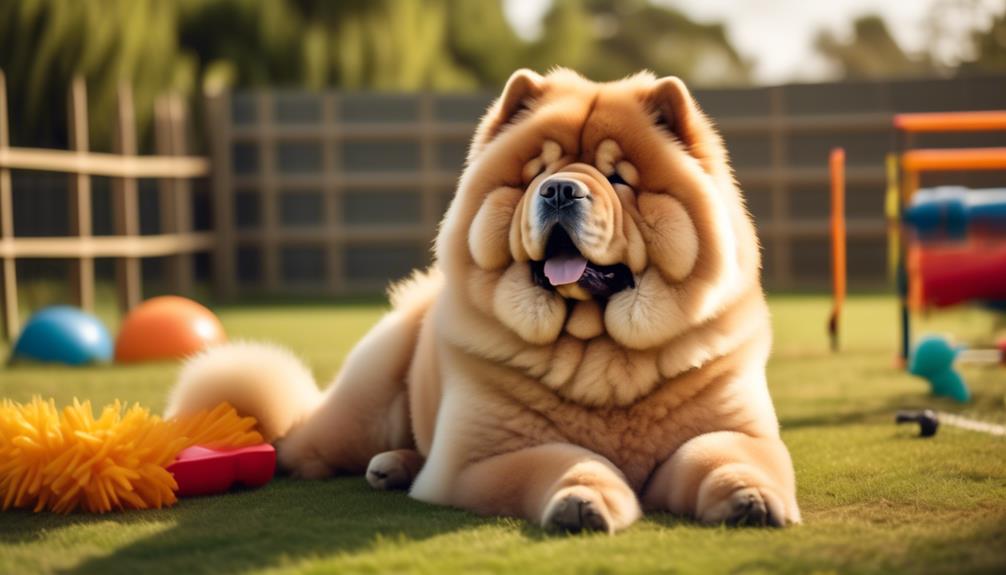
Living situations and exercise needs for Chow Chows vary depending on their individual temperament and activity level.
Chow Chows can adapt to various living situations, but they’re best suited to living indoors with their human companions.
They require daily exercise to maintain their physical and mental well-being, but excessive amounts of exercise aren’t necessary. A moderate walk or play session each day is typically sufficient to meet their exercise needs.
However, it’s important to note that Chow Chows have a tendency to be independent and aloof, so they may not always have the same enthusiasm for exercise as other breeds.
It’s important for owners to be patient and understanding of their Chow Chow’s individual exercise preferences and adjust accordingly.
Crate Training & Behavioral Training
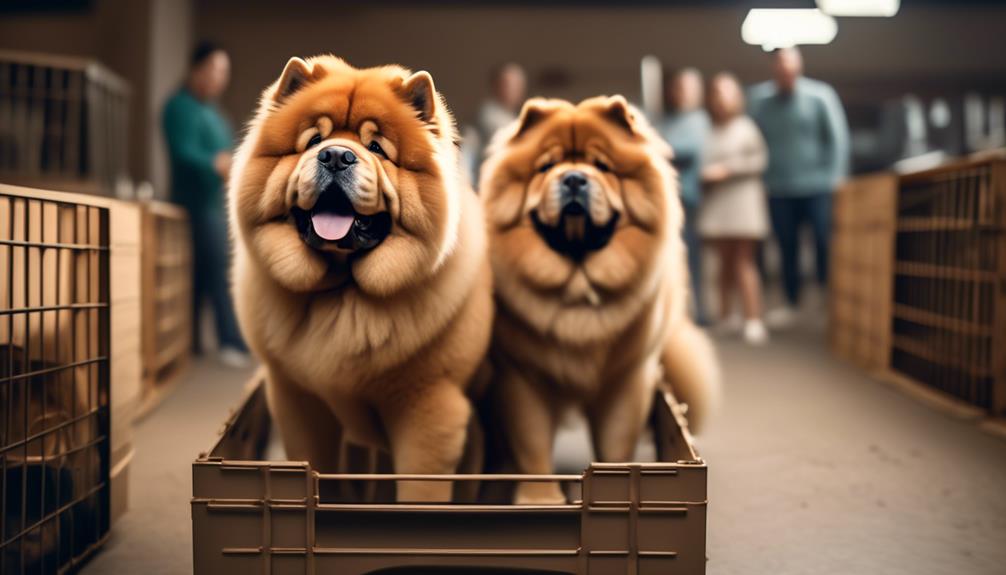
Crate training and behavioral training are important aspects of raising a well-behaved and disciplined Chow Chow. Here are some key points to consider:
- Crate training:
- Use a crate that’s the appropriate size for your Chow Chow.
- Introduce the crate gradually, making it a positive and comfortable space.
- Use treats and praise to encourage your Chow Chow to enter and stay in the crate.
- Behavioral training:
- Start training your Chow Chow from a young age to establish good behaviors.
- Use positive reinforcement techniques, such as rewards and praise, to encourage desired behaviors.
- Be consistent and patient with your training, as Chow Chows can be stubborn.
- Seek professional help if needed:
- If you’re struggling with training your Chow Chow, consider seeking the help of a professional dog trainer or behaviorist.
Feeding Guidelines & Portion Control
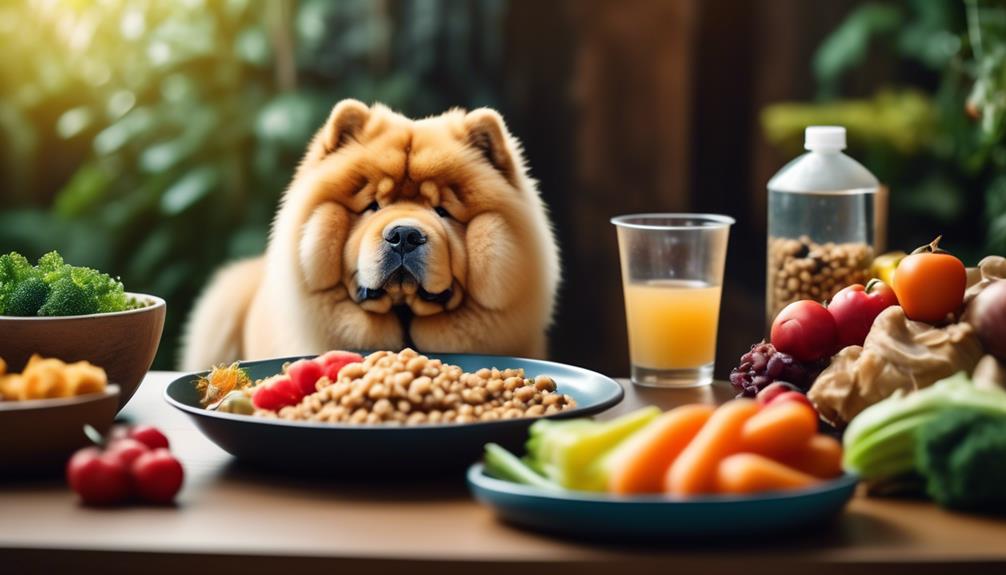
When it comes to feeding your Chow Chow, it’s important to establish proper guidelines and practice portion control. The recommended daily amount of high-quality dog food for a Chow Chow is 2 to 2 3/4 cups, divided into two meals. However, the specific amount needed may vary depending on factors such as size, age, metabolism, and activity level.
It’s crucial to measure the food and feed your Chow Chow twice a day to manage their weight effectively. The quality of the dog food also matters, as better-quality food provides more nourishment.
It’s essential to monitor your Chow Chow’s weight through visual and hands-on tests to ensure they’re being fed the appropriate amount. By following these feeding guidelines and practicing portion control, you can help maintain your Chow Chow’s overall health and well-being.
Importance of Quality Dog Food
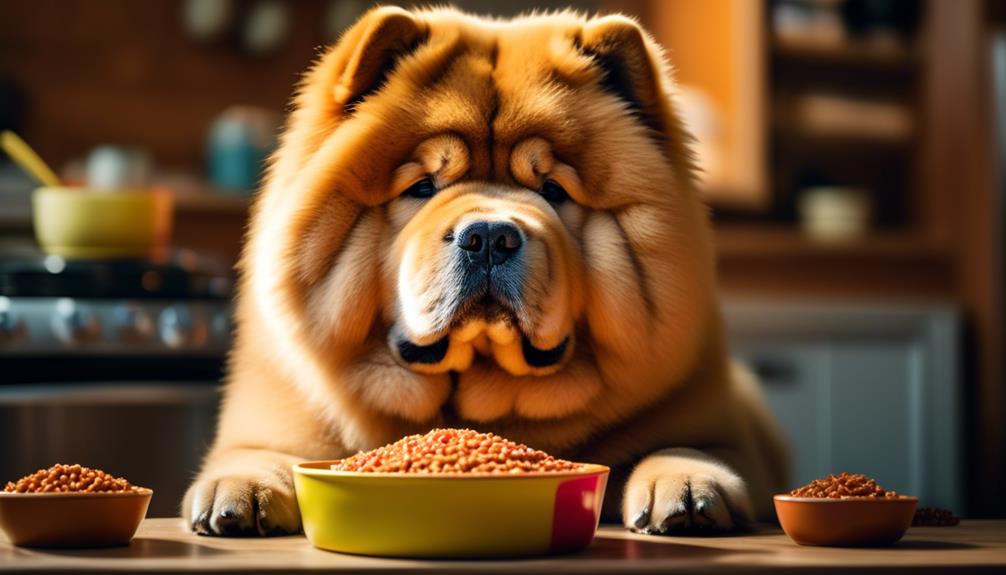
To ensure the overall health and well-being of your Chow Chow, it’s crucial to understand the importance of providing them with high-quality dog food. Here are three reasons why quality dog food is essential for your Chow Chow:
- Proper nutrition: High-quality dog food is formulated to meet your Chow Chow’s specific dietary needs. It contains essential nutrients, vitamins, and minerals that support their overall health and help prevent nutritional deficiencies.
- Digestive health: Quality dog food is made with easily digestible ingredients that promote healthy digestion. It helps prevent digestive issues such as bloating, gas, and diarrhea, which are common concerns in Chow Chows.
- Coat and skin health: Chow Chows have a thick, double coat that requires proper nourishment to stay healthy and shiny. Quality dog food contains essential fatty acids that support coat and skin health, reducing the risk of dryness, itching, and shedding.
Weight Management & Monitoring
Weight management and monitoring are crucial aspects of caring for a Chow Chow to ensure their overall health and well-being. As a medium-sized breed, Chows typically weigh between 40 to 70 pounds. Proper weight management is important to prevent obesity, which can lead to various health issues such as joint problems and heart disease.
To monitor a Chow Chow’s weight, it’s recommended to regularly check their body condition score and adjust their diet accordingly. Feeding high-quality dog food in the right portions, divided into two meals a day, is essential for maintaining a healthy weight.
Additionally, regular exercise and physical activity are important to keep Chows fit and active.
It’s important for Chow Chow owners to work closely with their veterinarian to develop a weight management plan that suits their dog’s individual needs.
Coat Types & Color Variations

The Chow Chow breed is known for its distinctive coat types and color variations. Chow Chows come in two coat types: rough and smooth. The rough coat is thick and abundant, while the smooth coat is hard and dense. Both coat types are available in five colors: red, black, blue, cinnamon, and cream.
Here are the coat types and color variations of the Chow Chow breed:
- Coat Types:
- Rough coat: Thick and abundant
- Smooth coat: Hard and dense
- Color Variations:
- Red
- Black
- Blue
- Cinnamon
- Cream
These various coat types and color variations contribute to the unique appearance of the Chow Chow breed. It’s important for Chow Chow owners to regularly groom their dogs to maintain the coat’s health and prevent excessive shedding.
Grooming Tips & Shedding Periods
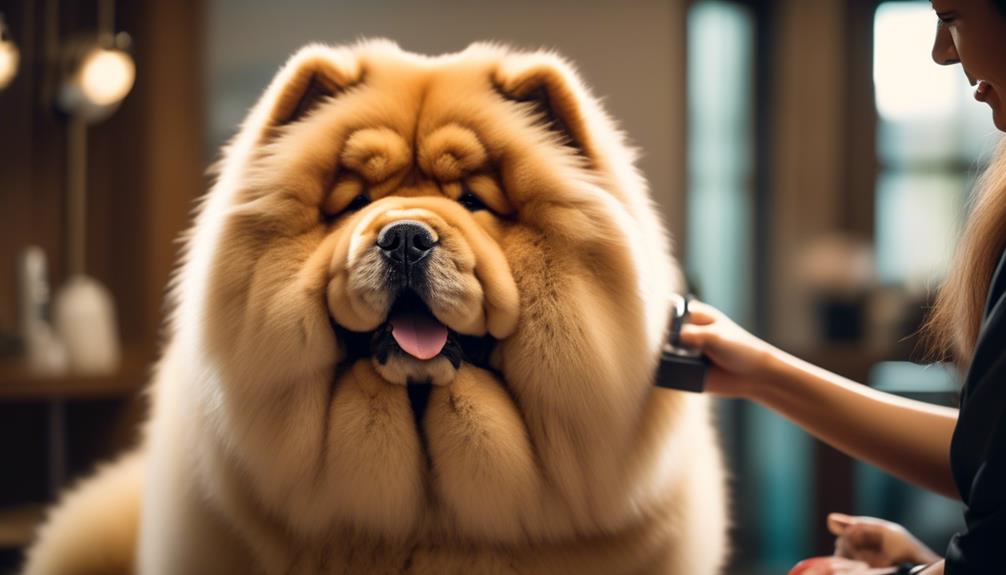
Regular grooming is essential for Chow Chow owners to maintain the health of their dog’s coat and manage shedding periods effectively. Chow Chows have a thick, double coat that requires regular brushing to prevent matting and remove loose hair. They are heavy seasonal shedders, so extra attention is needed during shedding periods to keep their coat under control. A helpful tool for grooming Chow Chows is a slicker brush, which can effectively remove loose hair and tangles. In addition to regular brushing, Chow Chows may also benefit from regular bathing to keep their coat clean and healthy. It is important to note that Chow Chows should not be shaved as their coat serves as insulation in both hot and cold weather. A grooming schedule that includes regular brushing and bathing will help Chow Chow owners keep their dog’s coat in optimal condition.
| Grooming Tips | Shedding Periods |
|---|---|
| Regular brushing | Extra attention |
| Slicker brush | Loose hair control |
| Regular bathing | Coat cleanliness |
| No shaving | Optimal insulation |
| Grooming schedule | Coat maintenance |
Conclusion & Final Thoughts
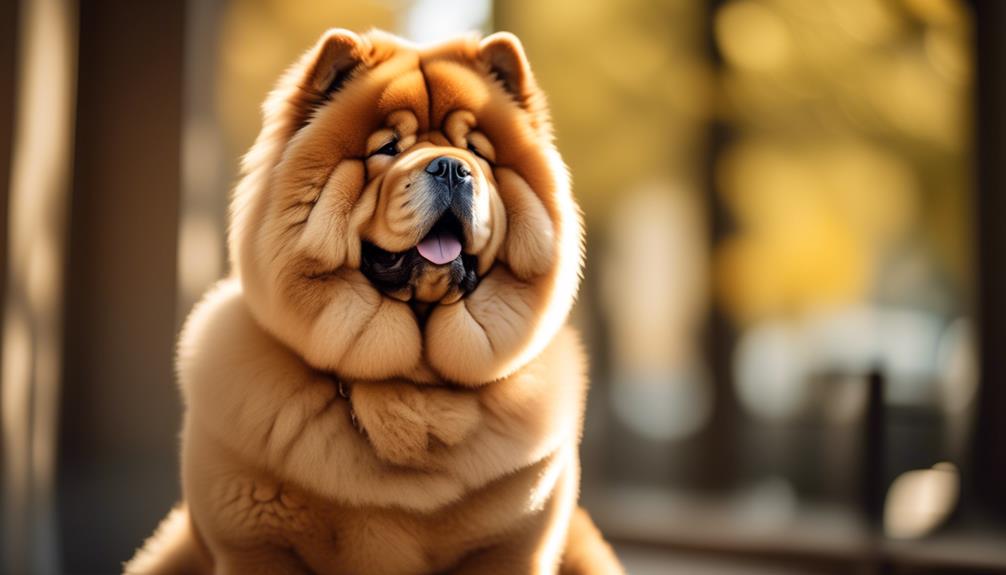
In summary, the Chow Chow is a medium-sized working dog breed originating from China, known for its thick double coat and independent yet dignified personality.
The Chow Chow has a rich history, with ancient names such as black-tongue dog, wolf dog, bear dog, and Canton dog. The breed gained popularity in the 1920s and even appeared in the White House. Martha Stewart is a fan, and they rank 64th in popularity among AKC-recognized breeds.
Chow Chows have a unique size and temperament. They range from 17 to 20 inches in shoulder height and weigh between 40 to 70 pounds. Their temperament is often compared to that of a cat: aloof, reserved, independent, dignified, intelligent, and stubborn. Proper socialization during puppyhood is crucial for a well-adjusted adult.
Health and care for Chow Chows include common concerns such as hip dysplasia, elbow dysplasia, entropion, bloat, allergies, and cataracts. They can adapt to various living situations but should be kept indoors with their human companions. They require daily exercise and consistent, firm training from an early age.
Frequently Asked Questions
Are Chow Chows Good With Children and Other Pets?
Chow Chows can be good with children and other pets if properly socialized from a young age. They have a reserved and independent temperament, but with early socialization and training, they can be friendly and accepting of other animals and kids.
How Often Should I Groom My Chow Chow?
Chow Chows should be groomed regularly to maintain their thick coats and prevent excessive shedding. Brushing should be done at least once a week, and during shedding seasons, more frequent grooming sessions may be necessary.
Can Chow Chows Be Left Alone for Long Periods of Time?
Chow Chows can be left alone for moderate periods of time, but they thrive on human companionship. They may become anxious or bored if left alone for too long. It’s important to provide them with mental stimulation and exercise when you are away.
Do Chow Chows Require a Lot of Exercise?
Chow Chows do not require a lot of exercise. They are independent and reserved dogs with a temperament often compared to cats. While they need daily exercise, it doesn’t have to be excessive.
Are Chow Chows Prone to Any Specific Allergies?
Chow Chows can be prone to specific allergies, such as food allergies or environmental allergies. It is important to monitor their diet and environment, and work with a veterinarian to identify and manage any allergies they may have.
What are the differences between Chow Chow and Flat-Coated Retriever dog breeds in terms of their characteristics and behaviors?
The Chow Chow and the Flat-Coated Retriever are dog breeds with striking differences in terms of their characteristics and behaviors. The Chow Chow is known for its independent and aloof nature, while the Flat-Coated Retriever is friendly and outgoing. When it comes to grooming, Chow Chows require extensive maintenance due to their thick coat, in contrast to the Flat-Coated Retriever’s moderate grooming needs. Understanding these key variances is crucial for anyone seeking comprehensive flatcoated retriever breed information.
Conclusion
In conclusion, the Chow Chow dog breed offers a unique combination of appearance, temperament, and history.
With its distinctive double coat and aloof personality, the Chow Chow stands out among other breeds.
Proper socialization and care are crucial for a happy and healthy Chow Chow.
Whether you’re a fan of this breed or considering adding one to your family, understanding their specific needs and characteristics is key to building a strong bond with these fascinating dogs.




